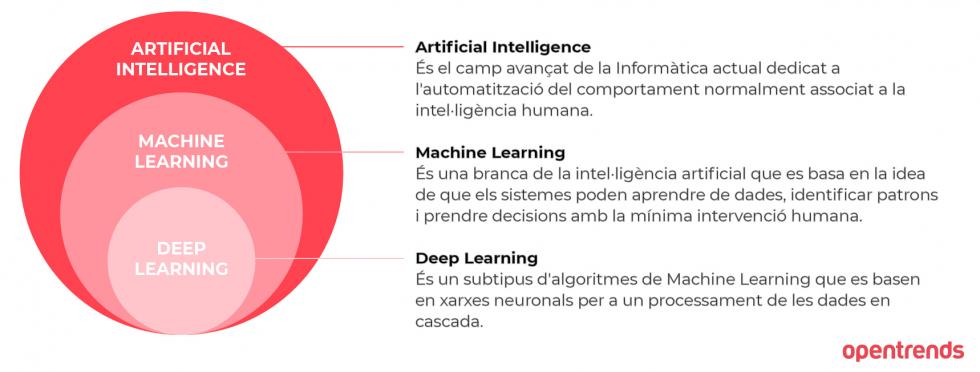
Basic concepts of Artificial Intelligence
When we talk about Artificial Intelligence, it often evokes a world of robots or futuristic technologies. However, Artificial Intelligence is already part of our daily lives.
An example of this is when shopping online and self-learning algorithms analyze our behaviors to recommend products adapted to us. Or Google Lens, which by uploading an image, identifies and links the products that appear in it. The picture below shows how we try Google Lens in our Barcelona office:

Artificial Intelligence (AI) is the advanced field of computer science dedicated to automating behavior commonly associated with human intelligence. Like happens with any complex science, many concepts are broken down from it. That’s why with this article, we want to start from the beginning and help you understand the basics of AI.
In this article we will talk about:
- Machine Learning
- The 5 Tribes of Machine Learning by Pedro Domingos
- Symbolists
- Connectionists
- Evolutionaries
- Analogizers
- Bayesians
- Types of Machine Learning
- Supervised Learning
- Unsupervised Learning
- Semi-supervised Learning
- Reinforcement Learning
- The 5 Tribes of Machine Learning by Pedro Domingos
- Deep Learning
- Neural Networks
- Cognitive Computing

Machine Learning (ML) is a branch of Artificial Intelligence that is based on the idea that systems can learn from data, identify patterns and make decisions with minimal human intervention.
In his book The Master Algorithm, world expert and leading researcher Pedro Domingos describes 5 tribes or currents of Machine Learning, that he divides based on their interests or origins:
- Symbolists: They are based on logic and philosophy, and practice inverse deduction
- Connectionists: They rely on neuroscience and try to connect small brains from what they call back programming to create a neural network that can interpret the data from their interconnections. Deep Learning comes from here.
- Evolutionaries: They are based on evolutionary biology and try to apply genome and DNA evolution principles, claiming that algorithms will evolve and adapt to unknown conditions and processes.
- Analogizers: They rely on psychology and see analogy as a basis for solving any problems that may arise.
- Bayesians: They are based on statistics and probability. His algorithm, probabilistic inference, learns by trying to calculate how improbable a fact is to rule it out as a possible solution.
We also find 4 types of Machine Learning depending on the need for human supervision:
- Supervised Learning: It learns by receiving a lot of labeled training data that allows generalizing in new cases.
- Unsupervised Learning: It learns by observing, understanding, and abstracting patterns directly from the information. It is very similar to how we humans think.
- Semi-supervised Learning: It learns based on both labeled and unlabeled training data, with the proportion of unlabeled data typically being larger.
- Reinforcement Learning: It learns from experience through trial-error and reward-punishment. This technique is being widely studied since it does not require large amounts of data.
Deep Learning (DL) derives from the connectionist’s approach. It is a subtype of Machine Learning algorithms that rely on neural networks for cascading data processing. The term “deep” refers to the number of layers hidden in neural networks.
Neural Networks (NNs) belong to the family of Machine Learning algorithms and are inspired by the functioning of neurons in the human brain. They are based on the fact that, given some parameters, there is a way to combine them to produce a specific result. The data goes through different layers in which a series of learning rules are applied until reaching the last layer, where results are compared with the "correct" one and the parameters are adjusted based on the "weight" function given in each rule. Once the network has learned, it can fix its “weights” and run in memory or execution mode.
Finally, some authors mention Cognitive Computing (CC) as another variant of Artificial Intelligence. It consists of systems that take on tasks or make specific decisions as assistants or substitutes for people, as they can handle ambiguity and vagueness, and have a high degree of autonomy within their area of knowledge.
As previously mentioned, AI is already here, but there is still a lot of work to be done, not only in terms of exploiting all its potential to get closer and closer to human intelligence, but also about being able to control its misuse.
The goal is to prevent what Elon Musk predicted: "machines could start a war by publishing fictitious news, stealing email accounts or sending fake press releases, just by manipulating the data.". We could say that it already happened when, through AI, sexual scenes were manipulated by replacing the faces of people appearing on them by those of well-known artists.
We must be aware of the improvements that AI brings to our lives, but without forgetting that we need to use it wisely.










